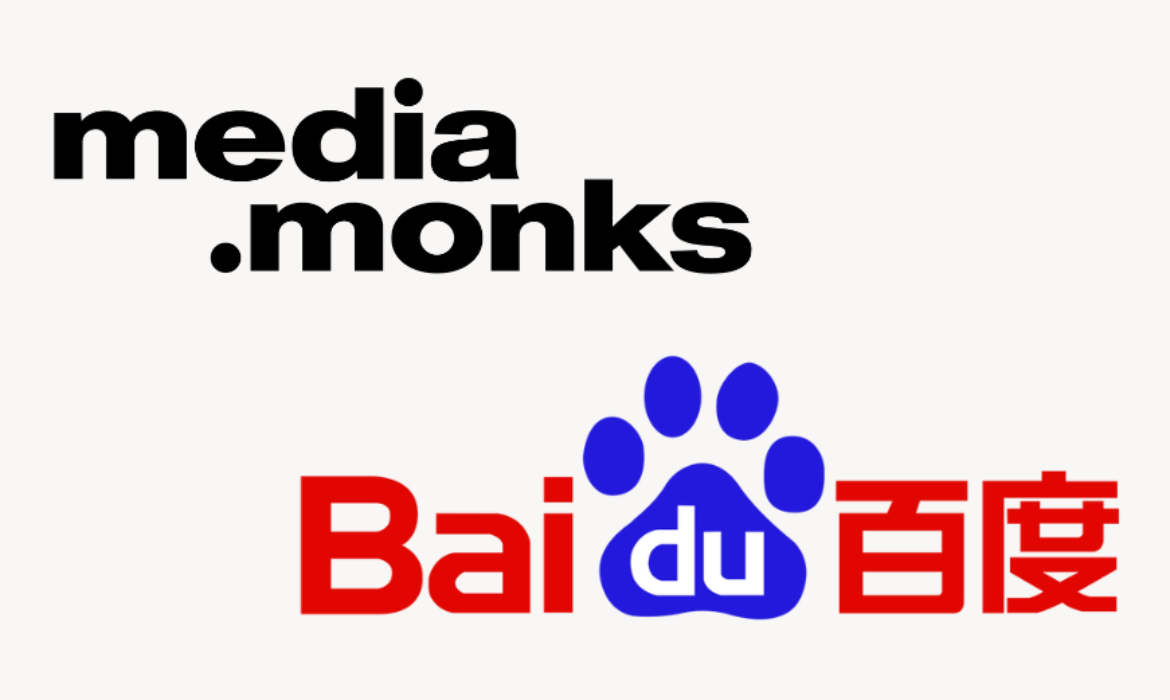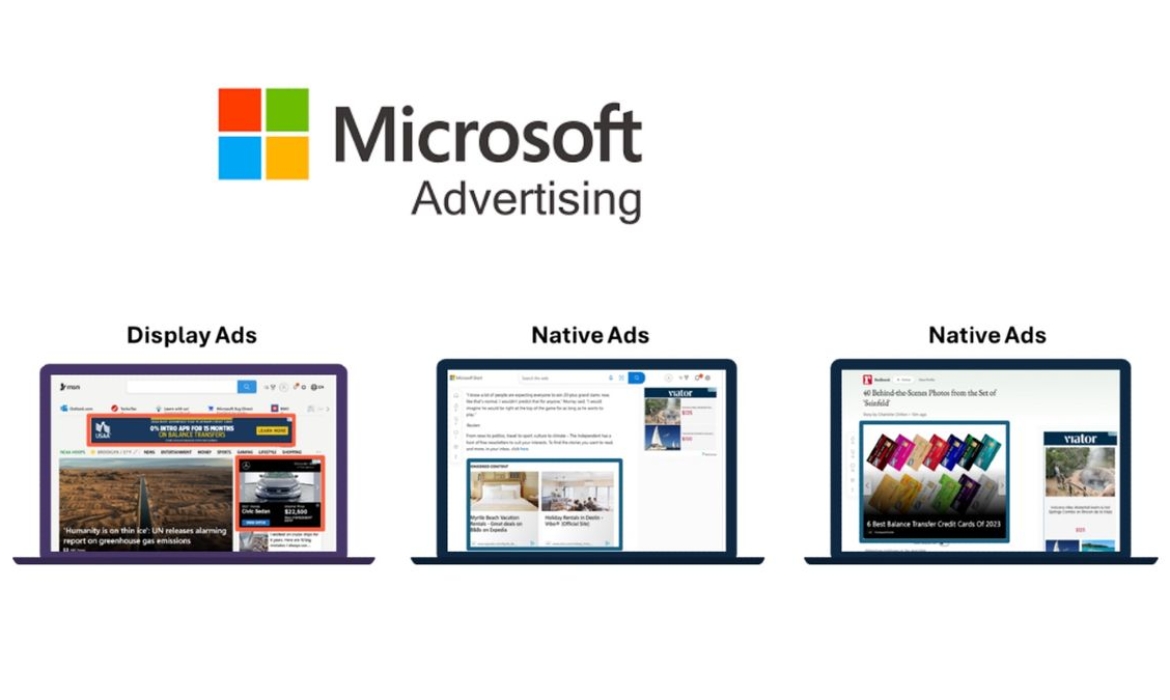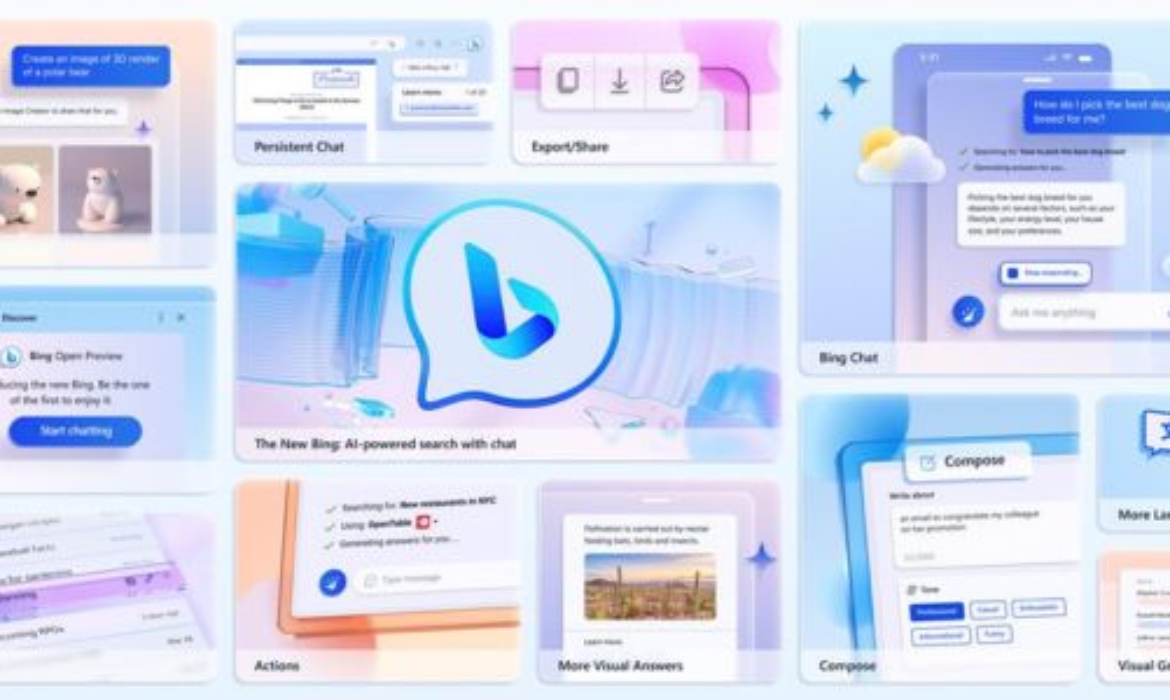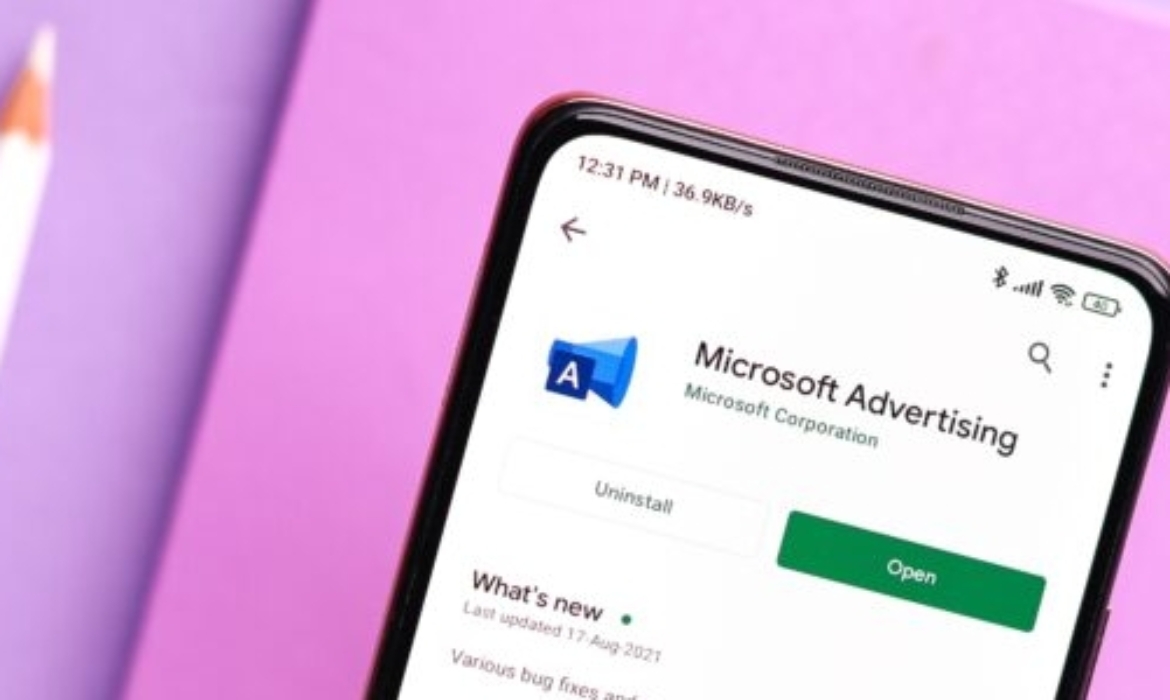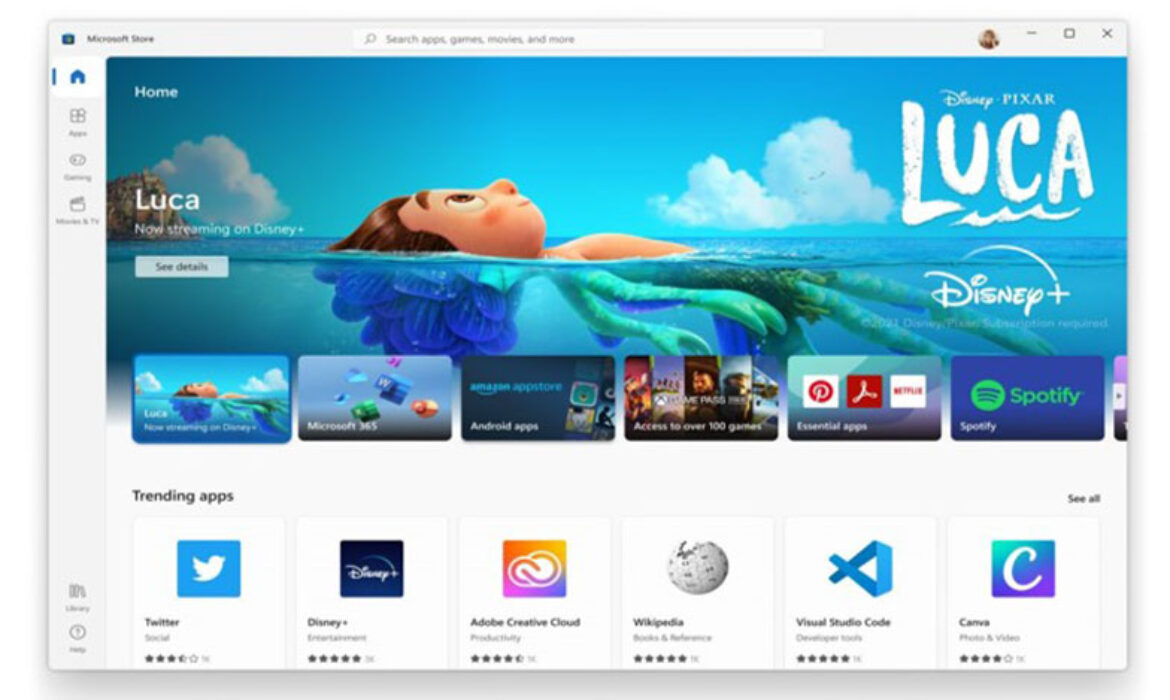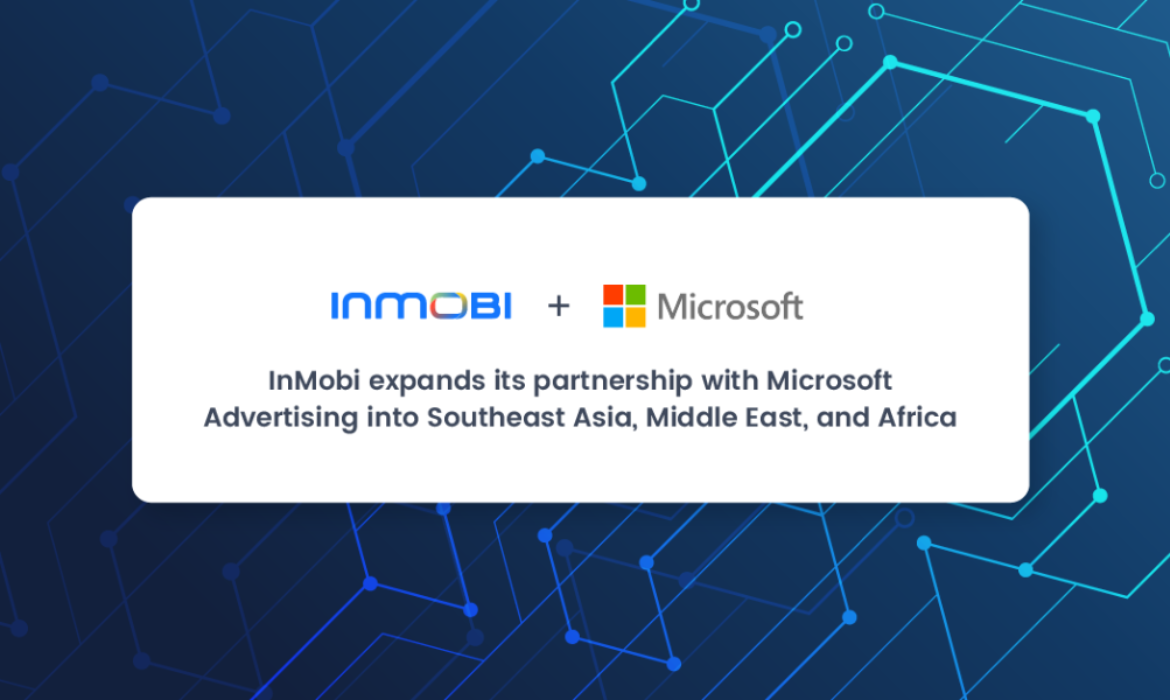AudienceProject Partners with Microsoft Advertising; YouTube Delays Co-Viewing Measurement Plan
AudienceProject Partners with Microsoft Advertising
Research instruments and audience measurement services AudienceProject has reached a deal with Microsoft Advertising. The goal of the partnership is to give advertisers continuous and independent audience measurement. This is especially true for advertisers using Microsoft Platforms in the UK and Germany. The Danish software provider has extended its current programmatic advertising campaign audience measurement in Microsoft Advertising. It encompasses digital video, connected television, and Netflix commercials. This will assist in gaining knowledge about the frequency and reach of campaigns.
Privacy-first data matching
To optimize their media buying, advertisers can obtain insights about Microsoft Advertising alone or in conjunction with other channels like Facebook, Instagram, YouTube, and Amazon. “Privacy-first data matching” between Microsoft Advertising and AudienceProject enables the measurement. It is only being rolled out to the UK and Germany at first because the two companies are currently testing to make sure the integration and the resulting measurement meet a range of minimum standards for independent measurement. AudienceProject confirmed that as the service is extended globally, more nations—especially France—will follow.
Here’s what they said
Brian Meritam Larsen, vice president of partnerships at AudienceProject, said
We experience a high demand for independent measurement of campaigns bought through Microsoft Advertising – both alone and in combination with other channels. We are very pleased that we can now offer advertisers this, helping them get valuable insights for more efficient budget allocation.
Jason Gruber, senior director of business development at Microsoft Advertising, shared
We want to help advertisers reach audiences across screens with premium advertising. We are pleased to be collaborating with AudienceProject, as their audience measurement solution allows advertisers to better understand how effectively their ads are reaching their desired audiences.
Read More: Microsoft Advertising and Media.Monks Unlock New Opportunities in China
YouTube Postpone Co-Viewing Measurement Plan
The co-viewing ad measurement plans that YouTube had originally planned to implement in the first quarter of 2024 have been postponed. They are now anticipated for the upcoming fourth quarter. Initially, the video platform intended to begin measuring and accounting for multiple viewers in a household. They would do so by using its co-viewing metric. Although there has been strong resistance to the new measurement plans from ad buyers since their announcement last summer, YouTube intends to roll out co-viewing to provide advertisers with a more complete image of their audience on the platform. Some executives are dubious about how precisely co-viewing measurement will count viewers following the specifications of a campaign and how the adjustments will impact the cost of ads.
Agency executives’ views on co-viewing plans
Agency executives expressed their hope that YouTube would use the delay as an opportunity to improve its co-viewing measurement plans. Furthermore, they also hope it addresses some of their issues and shares more information about its methodology with ad buyers. Since YouTube announced in the summer that it would transact against self-reported co-viewing measurement figures, ad buyers have been against the platform’s co-viewing measurement plans. Advertisers can choose to transact against Comscore’s and Nielsen’s co-viewing measurement separately on YouTube.
Third-party measurement and co-viewing measurement launch
Prioritizing the global market launch of third-party measurement and co-viewing measurement validation ahead of the transaction start date is YouTube’s stated strategy. Additionally, some agency executives simply don’t trust co-viewing measurement in general. Measurement of co-viewing is not a precise science. It usually takes into account a panel of chosen audience members. It is then projected to the entire audience using a co-viewing factor (e.g., 1.6) that multiplies the number of impressions served by the average number of people who are probably watching on the opposite side of those impressions.
Squishy math
Even though the math is a little fuzzy, it has proven sufficient for gauging traditional TV advertisements. These are primarily assessed using broad age and gender categories. However, agency executives are unsure of how precisely co-viewing measurement will count. Or more accurately, not count viewers according to a campaign’s targeting parameters given the level of audience targeting that advertisers are used to on platforms like YouTube. In light of this, agency executives see YouTube’s postponement as a chance to review the proper way to account for co-viewing in streaming, not just on YouTube.
Read More: DoubleVerify Includes YouTube Shorts in its Brand Safety Measurement Expansion
Microsoft Advertising and Media.Monks Unlock New Opportunities in China
Microsoft Advertising and Media.Monks have bolstered their positions in China to support marketing, advertising, and advanced services in two different announcements. Artificial intelligence is used to support services in the majority of cases.
Microsoft Advertising ventures into the Chinese market
Microsoft Advertising and InMobi have declared their intention to extend their partnership into the Chinese mainland. With Microsoft Advertising’s native display and search capabilities, Chinese marketers can now leverage an integrated solution to improve their campaigns. Its enterprise and strategic sales, account management, marketing, finance, collection, and billing for customers in China will all benefit from the partnership.
This will expand upon Microsoft and InMobi’s already fruitful partnership, which was established in July 2018. Since then, it has grown to encompass Microsoft Advertising’s solutions in almost 75 nations and regions, including Africa, the Middle East, India, Southeast Asia, and now Mainland China. The biggest search and tech company in China, Baidu, competes with Microsoft Advertising in the area. Baidu incorporates AI into all of its platforms and tools for cloud services and advertising.
Here’s what they said
Charlie Liang, GM of InMobi China, and SVP of InMobi Group said,
This extended collaboration between Microsoft Advertising and InMobi in China will bring the best value across both organisations to marketers in the region, given China’s highly competitive marketers environment. InMobi China is well positioned to bring the best experience to advertisers with a deep understanding of China’s search and display ad markets, a customer-oriented product and business operation team, and Microsoft Advertising’s cutting-edge solutions.
Read More: Chinese AI Firm Baidu Debuts ERNIE 4.0 Chatbot Competing with GPT-4
Media.Monks partner with Baidu to strengthen its presence in China
S4 Capital plc’s operating brand, Media.Monks China announced a partnership with Baidu to support international brands hoping to succeed in the Chinese market. Media.Monks, as a premium partner, is in a unique position to enable brands to leverage Baidu’s demand in China, which goes beyond Search and Programmatic Display to include a range of products, including Baidu’s AI-driven Ad-tech products.
The Data and Digital Media team (DDM.monks) emerges as a reliable partner for both inbound and outbound clients across diverse industries in the ever-changing landscape of China’s digital market. DDM offers a wide range of services, with a focus on programmatic display, data solutions, paid search, paid social, managed media, and brand marketing. DDM assists clients in navigating the challenging world of digital marketing in China and around the world, producing significant outcomes and promoting long-term growth, from carrying out media strategy to attaining data-driven efficiency.
With this new partnership, Media.Monks China can now offer a wider range of products to brands on the market. To enhance their influence in this dynamic and quickly changing market, Media.Monks and Baidu plan to collaborate closely in related fields in the future. They will also provide superior services to a wide range of customers.
Here’s what they said
Emily Yaoli, Data and Digital Media China team lead at Media.Monks remarked,
We will help brands with an integrated marketing strategy targeting mass audiences in China, by leveraging Baidu’s profound AI-driven solutions.
Read more: Baidu unveils ERNIE, the AI-powered chatbot to ChatGPT
Microsoft Unveils pubCenter for Small, Mid-Sized Publishers to Monetize Websites
Microsoft unveiled pubCenter, a brand-new advertising platform made to help small publishers monetize their websites. Microsoft wants small and medium-sized publishers to use pubCenter for display and native advertising from the Microsoft Advertising Network in order to monetize their websites. It is promoting its 15-year-old Google AdSense alternative as a pilot program for American advertisers only. With the help of Google AdSense, website owners can make money by running advertisements on their pages for free. AdSense publishers receive a portion of Google’s revenue from advertisers who pay Google to display their ads on their websites. Microsoft Advertising thinks they have a way to help advertisers; all it takes is a little tag put on the business website.
PubCenter – a simple and effective way to monetize websites
Microsoft launched the pubCenter program about 15 years ago. It has now redesigned the platform to enable tailored and relevant native and display ads that match consumer intent, publishers must insert a tag. Its goal is to assist small and medium-sized publishers and creators in making money or covering expenses. Additionally, it gives publishers the ability to control how many advertisements appear on the website, where they appear, and whether or not to display irrelevant content for users.
The new Microsoft pubCenter is now available as a pilot program in the United States; a global rollout is scheduled for the upcoming months. Microsoft PubCenter is a code-on-page advertising solution designed to simplify the process of introducing programmatic advertising to businesses. Companies must create an account and add one piece of code to their website. Following that, Microsoft pubCenter will display advertisements from the Microsoft Advertising Network, which consists of marketers from the Microsoft Advertising Platform and Microsoft Invest.
Read More: Microsoft Advertising Enters the Video and CTV Advertising Realm
How does Microsoft pubCenter work to monetize websites?
Companies give permission for the ads to appear on their websites. After that, advertisers from the Microsoft Advertising Network compete for ad space. The company may get paid when advertisements are displayed on its website. For instance, a small business owner may be considering trying an alternative ad network after already using Google AdSense to monetize their websites. Publishers choose an ad format and add website codes, much like with AdSense, to get paid each time an ad is served on the website. Only in situations where it anticipates a higher bid will the system serve ads.
While marketers fight for space on the Microsoft Advertising Network, bloggers and website owners are attempting to attract readers with quality content, like insider tips on the best local hiking spots or dining establishments. pubCenter assists in monetizing the website with highly targeted and pertinent native and display advertisements that fit customer intent and profiles. Unlike other programmatic platforms, Microsoft pubCenter allows them to get started quickly.

Image credit- Microsoft Advertising
What does Microsoft pubCenter offer?
- Flexible mediation: Companies using Google AdSense units can also employ Microsoft pubCenter advertising. When Microsoft anticipates a higher bid, it will only show its advertisements.
- Placement of ads: Companies are free to select where and how many advertisements appear on their website.
- Enhanced advertisements: Microsoft PubCenter displays advertisements that are appropriate to the businesses website’s content and the interests of its users.
- No minimum revenue requirements or sign-up fees: Companies can use Microsoft PubCenter without having to meet any minimum revenue requirements or volume constraints.
Microsoft Advertising feels that pubCenter gives publishers more control over modifications. It gives them the ability to manage and steer ad inventory. Its goal is to enable all artists and founders to maximize the potential of content monetization.
Read More: Microsoft Advertising Enhances Search and Ads with Generative AI
Microsoft Advertising Enhances Search and Ads with Generative AI
Microsoft Advertising’s search and advertising platforms have received a number of generative AI improvements. They plan to completely reimagine how users engage with search engines and online advertisements. The internet giant announced earlier this year that it would include generative AI into its services to alter how they functioned. The objective of Microsoft is to transform search and advertising using generative AI. The newly introduced functions, Compare and Decide Ads, Ads for Chat API, and Copilot are a part of that mission.
Microsoft and AI Integrations
According to Microsoft’s data, younger people enjoy using Bing Chat, the company’s AI-powered conversation function. Additionally, it motivates people to decide more quickly. Users on Chat apparently make decisions in half the time it takes them to do so using conventional search techniques. Microsoft’s Edge browser had tremendous growth, which further internal statistics attributed in part to the seamless integration of Bing AI Chat.
Compare and Decide Ads Offering engaging conversational experience
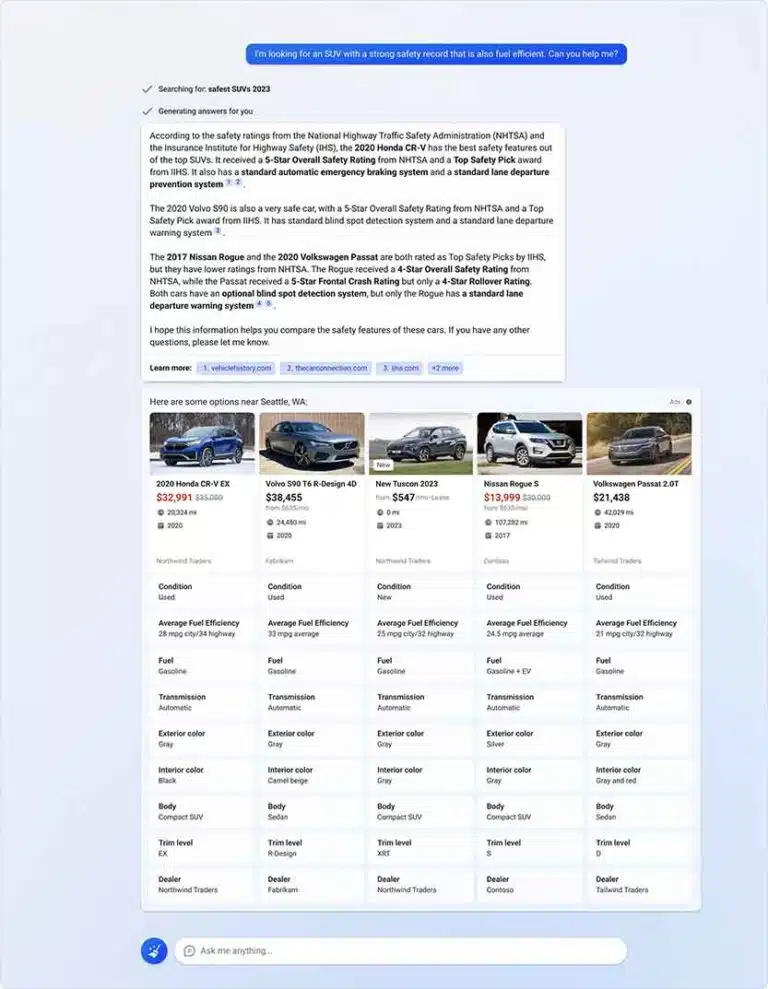
Image credit- Search Engine Journal
Microsoft has launched several innovative advertising formats specifically for the Bing Chat experience. Ads called “Compare and Decide” are the first of them. Online buyers will be able to compare various products using the criteria they find most important thanks to this new structure. These advertisements, scheduled for a closed beta in early 2024, will transform advertising in the travel, auto, and retail industries by compiling all pertinent facts into a clear table. To further assist advertisers in connecting with AI chat users, Microsoft also expects to roll out new Conversational Ad experience forms over the upcoming months.
Read More: Media.Monks Unveils AI Integration for Customized Content
Ads for Chat API Partners
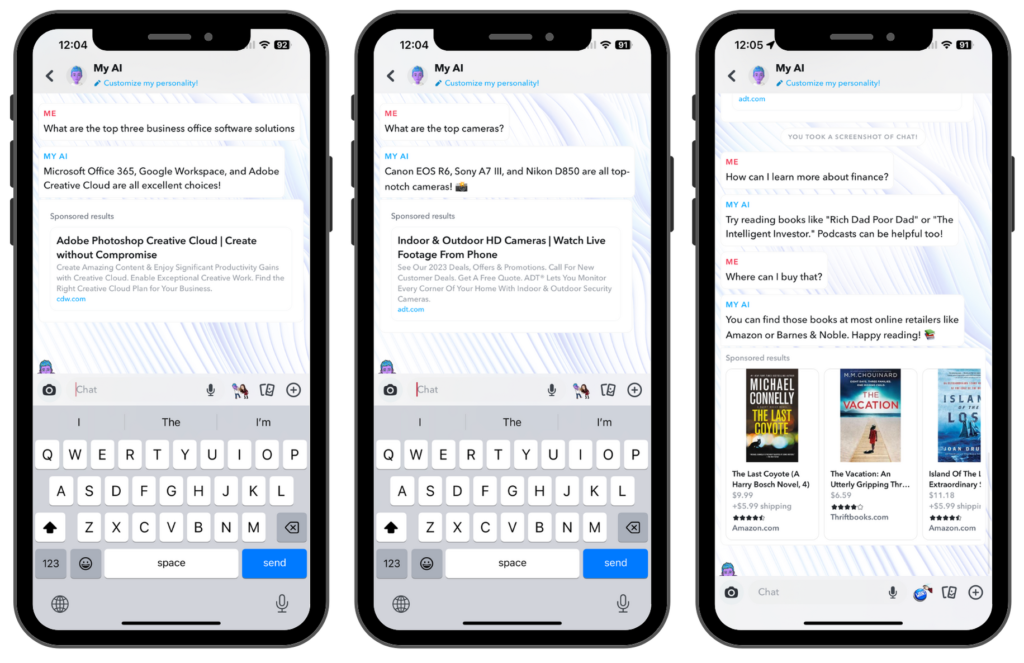
Image credit- Search Engine Land
Microsoft has revealed the first two partners for its new offering leveraging the new advertising for Chat API in addition to the new Conversational Ad Experience. On Snapchat’s My AI chatbot, the well-known social media platform, which is visited by 150 million users worldwide, makes use of the technology to serve Sponsored Links in pertinent material and interactions that feel natural to the content flow.
Axel Springer’s Hey_, which receives 16–17 million visitors per day, has also adopted the advertising solution. It runs on BILD.de. It is sponsored by Microsoft Advertising’s Ads for Chat API, and powered by Microsoft Azure Open AI Services. Microsoft added that it would keep improving its API selection in response to feedback from its partners and advertising. The internet giant plans to reply to comments made by its current partners regarding the Ads for Chat API service before further extending it.
Copilot for Microsoft Ads
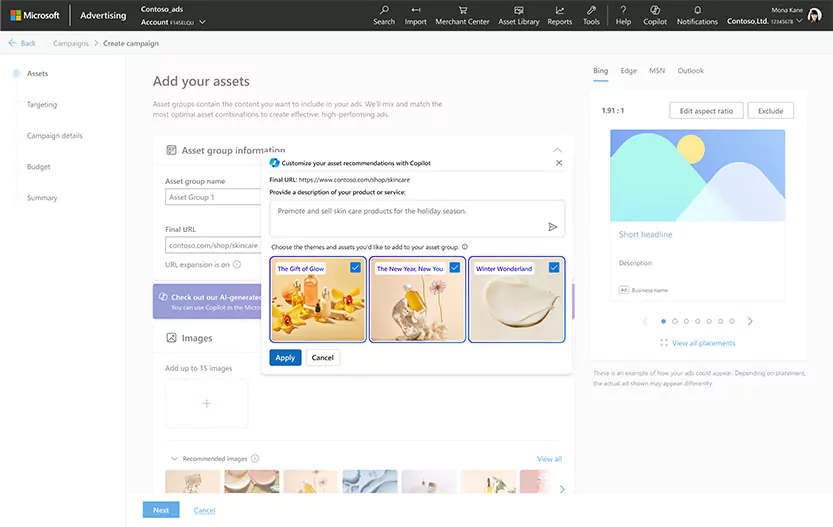
Image credit- Search Engine Journal
The Copilot in the Microsoft Advertising Platform is another revolutionary feature. This knowledgeable assistant was created with advertising and agencies in mind. Additionally, it makes use of AI to provide suggestions for product headlines, photos, and descriptions. Advertisers can use it by simply describing the material they require, such as a picture. Based on their descriptions, Copilot will produce ideas. Microsoft is testing the service with a select group of marketers before making it available for open beta testing in the upcoming months.
Unified Copilot
Microsoft’s recent announcement of AI-enhanced Windows 11 platform has increased the appeal of its products. The company’s online and productivity applications Bing, Edge, and Microsoft 365 will all be compatible with the new AI tool, named Copilot. On September 26, the upgraded software will be released together with the most recent updates to Windows 11. On Nov. 1, when the eagerly awaited proprietary AI product will be sold, it will be accessible in Microsoft 365 Copilot.
AI’s continuously modifies advertising and search
The improvements made to Microsoft’s advertising and search features have a big impact on the advertising sector. This is because they provide better user experience and more precise targeting. It is crucial to stay up to speed with new ad products and targeting tools. It helps to guarantee that advertisers are providing the best user experience and reaching high-value customers,
Read More: Microsoft Advertising Enters the Video and CTV Advertising Realm
Microsoft Advertising Enters the Video and CTV Advertising Realm
At the DMEXCO conference, Microsoft Advertising unveiled a brand-new video ad product called Video and Connected TV (CTV) ads. Advertisers can now create online video and CTV ad campaigns on the Microsoft Advertising platform, thanks to the company’s video ad offering. The novel solution offers specific reach across large-scale properties to guarantee that the ad is presented to the appropriate target audience. The offering engine accepts search data. The internet juggernaut wants to profit from the burgeoning digital video landscape. By 2024, it is anticipated that people will spend 3.5 hours daily on average.
How does it work?
The new platform does not require advertisers to learn how to use the new platform. No set-up fees or lengthy onboarding procedures are needed, and campaigns are straightforward to optimize. The same platform offers the possibility to target ads on CTV. Because of this, creating campaigns only requires a few clicks. The only thing advertisers need to do is upload video assets that best represent their brands. Additionally, they must determine who they want to expose their ads to as well as how frequently they should do so across multiple devices. Setting frequency caps, reporting on domains where ads are served, and excluding any domains where ads should not be served are all features available.
Why should advertisers care?
Video and connected TV (CTV) capability increases conversion possibilities. It expands the options for ad-serving and using audience analytics to target high-value consumers. The choice to run commercials online or on CTV is also available. Advertisers can purchase CTV ads through a cost-per-completed view mechanism to target audiences on smart TVs and connected devices.
Moreover, according to Microsoft, search data is one of the most important components to enable this CTV and video service. Even when watching television, online searches have developed into one of the most potent intent signals. It is now a clear indicator of consumer intent. It reveals what the current needs of consumers are. Search offers information that can later be converted into marketing.
The rise of multi-screen viewing
As multi-screening is becoming popular, Microsoft’s new offering comes at a crucial time. According to recent studies, 4 out of 5 consumers read online news while watching TV, highlighting the opportunity for advertisers to target audiences who engage in multi-screen behaviors. Furthermore, 90% of Gen Z viewers in the U.S. utilize a second screen in addition to TV. This behavior creates attractive opportunities for marketers to better engage viewers. Even though the data just pertains to the U.S. market, the product is currently conducting pilots in 34 markets, with more than 405 billion monthly CTV impressions and 1.6+ trillion video impressions.

Image credit- Microsoft Advertising Blog
Video and CTV ads highlights
Microsoft’s access to billions of first-party data points is what distinguishes this platform. It makes it possible for advertisers to precisely identify their target market. Advertisers can target viewers on desktop, smartphone, and tablet devices with online video advertising purchased using a viewable CPM model for both in-stream and out-stream placements. User behavior from Bing, Microsoft Edge, Microsoft Start, and other properties is included in this treasure trove of data.
Max, Hulu, and Bloomberg are just a few of the venues where you can see video and CTV advertisements. Additionally, it has been reported in media sources like the Wall Street Journal, MSN, and the Huffington Post. A hyper-targeted audience is created by the platform using machine learning algorithms based on a variety of variables, including product preferences, demographic data, and browsing patterns. The goal of this strategy is to make targeted ads better so that marketers can reach the most relevant audiences.
Read More: Loop Media-Microsoft Advertising Forge New CTV OOH Inventory Category
Search data insights
One type of data used to create intelligence signals is search. However, Microsoft permits the use of billions of legal first-party data sets across numerous properties in advertising. They range from preferences for content and brands to LinkedIn profiles and much more. All of these signals are applicable to the video targeting feature. Based on viewing and browsing information, Microsoft Advertising Video and CTV advertising enable advertisers to use these signals to place brands in front of viewers with the appropriate messages.
Forecasts suggest a significant increase in ad expenditure
Forecasts indicate that between 2023 and 2025, U.S. programmatic video ad expenditures will increase by $22.51 billion (30.2%). The latest feature from Microsoft is made to effectively develop this growing pattern. Another appealing factor is the ease of application. The announcement is noteworthy because it signals a significant effort in an industry that is constantly developing. Additionally, it provides marketers with a more comprehensive, data-driven tool for audience interaction. Microsoft’s CTV and Advertising Video advertisements provide targeted audience capabilities. The growing rivalry and possible ad saturation have led to continuous innovation for success.
Here’s what they said
Product Marketing Manager at Microsoft Advertising, Liam Mackessy, told Search Engine Land:
This product has been designed for ease of use. You can get started in just a few clicks, there are no long onboarding processes, no set-up fees, and it’s simple to optimise. We’re making CTV advertising, which typically can be a little bit more complex to buy, more accessible to a lot more advertisers on the Microsoft Advertising platform. However, we still provide control and flexibility to advertisers – they can set their own frequency caps so that they can accurately plan budgets and campaigns accordingly. We also have the usual domain reporting and domain exclusions to help advertisers keep track of where their ads are serving so that they can decide which sites they may not want their ads to be served on.
Read More: Microsoft Submits Revised Activision Blizzard Proposal to UK’s CMA
Microsoft Store Ads Expand to Bing Search Results, Empowering Global Advertisers
Microsoft Store Ads now feature in Bing search results, granting advertisers worldwide access to a powerful marketing platform. This expansion brings targeted exposure to 150 new regions, amplifying opportunities for businesses. The announcement, made at Build 2022, showcased Microsoft’s commitment to assisting developers in growing their businesses and reaching their ideal customer base.
Enhanced Reach with Premium Search Ads
Premium Search Ads provide advertisers with expanded options to connect with customers, appearing in both the Microsoft Store and Bing.com search results. These visually prominent ad placements maximize customer engagement and drive higher app download rates, offering exceptional visibility in search environments.
Streamlined Advertising with Additional Features
Microsoft plans to introduce new features that streamline the advertising process. Through the Microsoft Advertising Software Development Kit (SDK), advertisers can retarget audiences across the Microsoft Network, boosting customer engagement and gaining valuable insights into app installations and in-app purchases.
Effortless App Linking and Tracking
The simplified user interface and redesigned layout allow advertisers to link their apps with a single click, making it easier for digital marketers to access app information. This enhanced tracking system enables comprehensive analysis of app installations, in-app purchases, and customer engagement, empowering advertisers to optimize their campaigns effectively.
Success Story of Miracle Games
Miracle Games, an early adopter of Microsoft Store Ads, experienced remarkable results. By targeting users searching for related apps and games on the Microsoft Store, Miracle Games achieved increased awareness, preference, and downloads. Their implementation of Microsoft Store Ads resulted in a 25% surge in installs and an outstanding 6x higher conversion rate compared to their previous use of Microsoft Advertising.
Leveraging Bing’s Extensive Search Volume
With Bing generating a colossal 14.5 billion global monthly searches (Comscore, March 2023), Microsoft Store Ads now extend beyond the Windows Microsoft Store. These ads seamlessly appear on Bing search engine results pages alongside regular product ads, providing access to an extensive user base and further amplifying brand reach.
Enabling Ads and Optimization
To enable Microsoft Store Ads in Bing search results, advertisers need to create a Microsoft Store Ad campaign within Microsoft Advertising and adjust their Ad Distribution Controls to “all.” This simple integration empowers advertisers to optimize their reach and capitalize on Bing’s vast user base.
Microsoft’s integration of Microsoft Store Ads in Bing search results represents a significant milestone for global advertisers. By combining the immense search volume of Bing with visually prominent ad placements, streamlined user interfaces, and advanced tracking capabilities, businesses can effortlessly expand their customer base and drive app downloads on a global scale.
Next Read: Advertise Your Brand in the Metaverse: The Future of Digital Advertising
InMobi, Microsoft Advertising Extends Partnership Into SEA, Middle East, And Africa
Adtech provider InMobi has announced an expansion of its partnership with Microsoft Advertising to support enterprise and strategic advertisers in new regions including Southeast Asia, Turkey, the Middle East, and Africa.
InMobi will offer marketers an integrated solution to ramp up their campaigns built on the search and native display capabilities of Microsoft Advertising and the mobile ad tech capability of InMobi’s advertising platforms.
Interesting Read: Is Microsoft Reinventing Its Ad Business With Massive Acquisitions?
Microsoft and InMobi have been working together since July 2018 to help enterprises accelerate their digital transformation through insights, audiences, and engagement platforms. Continuing the partnership in 2019, InMobi added Microsoft Advertising products and solutions to its offering in India. Microsoft Advertising offers solutions that reach people across Microsoft properties, including Bing, Microsoft News, Edge, and Outlook, as well as on partner sites like AOL and Yahoo.
In the past 2.5 years, InMobi and Microsoft have shared a successful partnership in establishing an Indian footprint. With a 1.8X growth in India business since 2019, Microsoft Advertising’s APAC vice-president, Nick Seckold, said,
“InMobi’s successful track record in India has led Microsoft Advertising to extend its coverage across Southeast Asia, where it will be tasked with building close relationships with advertisers and agencies to grow the business in the region.”
Microsoft Advertising’s EMEA and LATAM vice-president Mark Richardson also commented that InMobi will expand its representation of Microsoft’s full suite of advertising offerings to strategic and enterprise clients in West Asia, Turkey, and Africa.
Rohit Dosi, General Manager, Microsoft Advertising business at InMobi, will take up additional responsibilities in the newly expanded regions and also said,
“The extended partnership between Microsoft Advertising and InMobi will enable marketers to deliver a unified brand experience to customers by bringing together the best of search and native display platforms across both organizations. We are positioned uniquely to bring Microsoft Advertising to marketers in Southeast Asia, the Middle East, and Africa through our deep appreciation of marketers’ needs, a keen understanding of the markets, and a customer-obsessed team.”
InMobi will be responsible for the sales, account management, marketing, finance, collection, and billing for Microsoft Advertising customers, managed by InMobi, in India, SEA, and MEA from now onwards. Direct billing with InMobi is designed to provide advertisers with an easy and hassle-free advertising experience as they leverage InMobi’s services.
Interesting Read: InMobi And Anzu Partners To Bring Programmatic In-Game Ads To APAC Region


